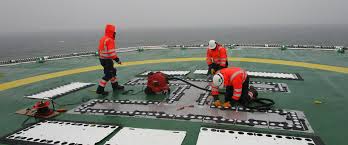CAP437 7th edition, Appendix C describes the new lighting system which will outline the ‘H’ and landing circle with LED lights. “The new lighting scheme has been clearly demonstrated to provide the visual cues required by the pilot earlier on in the approach , and much more effectively than floodlighting and without the disadvantages associated with floodlights such as glare” (ch 3, para 3.4)
Highlights of the requirements of the new standard:
- Existing perimeter lighting requirements remain unchanged
- Existing floodlights may also be retained for the purpose of providing a source of illumination for on-deck operations such as refueling and passenger handling
- The landing H and circle will be lit by continuous lights
- The lights should not be higher than 25mm above the deck surface
- The lights and all components should be durable and tested to withstand 15MT (240lbs/sq inch) helicopter landing loads.
- As the new lights are now integrated into the helideck landing surface, it is important to have proper installation methods to ensure the structural and operational integrity of the helideck.
Correct installation becomes crucial since the lights are now integrated into the helideck landing surface. We have developed appropriate installation procedures, in conjunction with the lighting manufacturers, to ensure the structural integrity, durability and water-tightness of our helidecks.
Stage 2 lighting is therefore a new lighting system component which becomes compulsory for new builds with effect from May 2012 (7th edition CAP437).
For existing helidecks, UKCAA considers that a “reasonable time frame for implementation is within three years for at least half of all helidecks being operated… and for all helidecks (within the purview of UKCAA regulations) by 31 Mar 2018”. (UKCAA Safety Regulation Group letter dated 26/02/2013). The advice is that helidecks be prioritized and those regarded as high priority be retrofitted first.




